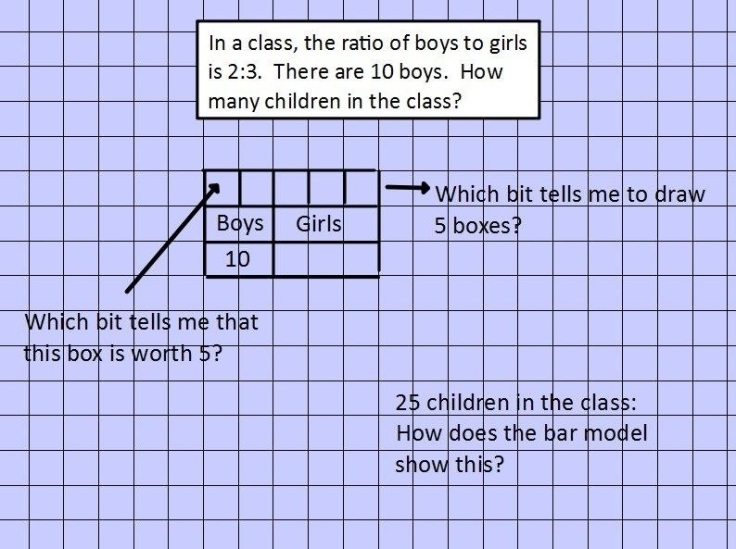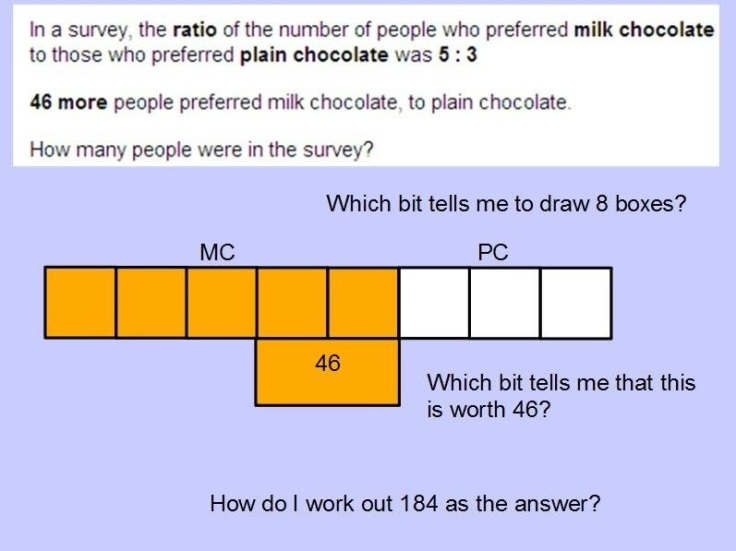Experts, say Hattie and Yates, see and represent problems on a deeper level, whereas novices focus on superficial aspects. With this in mind, take a closer look at one of the most prevalent strategies for solving problems:
In some variants of the acronym, the U even stands for ‘understand the problem’! If children practise solving problems in this way, they can only get better at analysing the superficial structures of the problems. Some of the advice leads children to develop near useless strategies when problems get trickier. At its worst, I’ve seen (and probably set up myself) lessons where children are told that they are doing subtraction word problems. Every problem has the same sort of language pattern and children could feasibly get by simply by picking the numbers out and subtracting one from the other.
Take the ‘underline’ and ‘choose which calculation’ advice. Underlining key words may well be useful by there is often ambiguity in the wording used. ‘How many more than X is Y?’ is different to ‘What is X more than Y?’ Although the wording is similar, they require different calculations.
If children are to understand the deeper structures, then they need to know the deeper structures. And of course they’ll need to practise analysing problems to classify those structures.
In the example of multiplicative reasoning we can start by suggesting that there’ll be three basic structures.
By modelling the thinking behind this and relating the wording used in the problem to the bar models, children can be shown the three deep structures. Certainly, they’ll need to practise over time analysing problems like this to become skilled at it. In the first instance, a little guided practice is on order: sort these problems by underlying structure:
Note that a deliberate difficulty built into this practice is that the problems are all similarly worded. There’s a decision to be made about the work that children will do to practise further. Do they solely work on sorting by deep structure or do they solve the problems too? In the example below, some children worked on just the first column. Novices have comparatively weaker short term memories than experts so may only be able to deal with the sorting. It makes some sense to provide a scaffold to help them remember important information: the deeper structure of the problem.
Here is a similar approach when showing children the structures of problems involving ratio:
Once children are aware of the possible structures, the teacher can show them how to represent the problem. Bar models are great here. Plus, worked or partially worked examples are powerful in showing children how to grapple with a problem:
Children can then have a go on their own. Here are some example questions for them to sketch out with bars and solve:
And here is an example of what children who already understand the basics would be up to – much trickier problems with more layers that might not entirely fit the basic structures described to most children:
This work on deeper structures could start from an early age. Too often, problem solving like this is bolted on to work on calculation with the assumption that if children know which operation a word or phrase means, they can solve problems. This however, is only superficial analysis. Children need knowledge of the structures of problems, just like we teach them the structures of stories. Perhaps we should approach problem solving like this more along the lines of teaching reading comprehension…









I found this really interesting because although I am not a maths/primary teacher I do use Direct Instruction materials to help my children at home. In these Englemann builds in a ‘number family’ approach right from the start, to do the same job as your bar models. The child learns right from the start where the numbers go in the family depending on the problem. Your approach looks great.
LikeLike
Reblogged this on The Echo Chamber.
LikeLike
A brilliant blog- I have been arguing with myself against this approach for a couple of years now but didn’t know what to replace it with! Now I can go into school with an actual replacement idea to share with staff! This will support my argument against this instrumental way of teaching problem solving! Thank you!
LikeLike
Excellent will share
LikeLike
Thank you for this, really helpful. Out of interest which age groups have you taught this to, or think would get it?
LikeLike
Thanks for reading. The examples are from year 6 but with a few changes should be accessible for all of key stage 2. Something similar for additive reasoning could well work in key stage 1.
LikeLike
Reblogged this on educatingthoughts and commented:
A very interesting take on maths word problems
LikeLike
With year 1, I found last year that pupils needed to be explicitly shown how subtraction relates to stories where we know the whole and one part and we need to find the other part. They have already worked with part-whole models with number bonds and addition stories. Hopefully, if they can identify the whole and parts, then they will be clearer about what calculation they need to do to solve the problem!
LikeLike
Absolutely. I think a combination of knowledge of the part – whole mode plus stories is a great way of understanding problem structures.
LikeLike
Thank – this was brilliant – It gives me a model I can use with staff, already introduced to Year 5 teachers and given them some examples to use with it. This model will really help staff and children with the reasoning and explaining, as well as improving their problem solving skills – I am sure.
LikeLike
Are there only three possible types of problems, or are the three outlined the only ones?
LikeLike
Good question. I’m working on something for Rising Stars which breaks the 3 down a bit more but essentially they are the basic structures, I think.
LikeLike
Excellent and very useful blog. RUCSAC is flawed and children are easily confused by it. I find that as a teacher it’s impossible to show children how the traditional method of problem solving (whatever that means) can help them solve any problem.
LikeLike
Agreed. Things like this seem to thrive though…
LikeLike